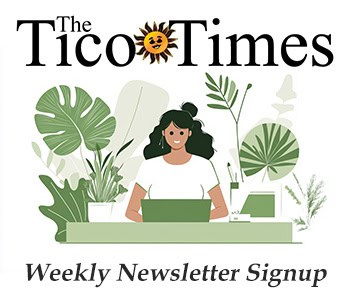The stork was either very busy or had help delivering babies last month to INBioparque in Santo Domingo de Heredia, north of the capital. Though nobody claims to have seen the big beaked bird, the evidence is all around.
New babies were discovered in the domiciles of the white-tailed deer, three-toed sloth, herons, wood rails, sheep, iguanas and yigüirros, or clay-colored robins – Costa Rica’s national bird – and 31 tiny tots were born to Eva the boa constrictor.
The snakes caused the most excitement because they came as a big surprise. Births in captivity are not all that common. Eva had lived with her two companions in a roomy snake tank for several years and nobody, not even her closest human companions, suspected she was pregnant.
“She did get a little chubby at the end,” said Felipe Quirós, a naturalist and biologist at the park, “but it could have been something she ate.”
All three snakes were donated to the National Biodiversity Institute (INBio) park six years ago. Their ages are uncertain.
Boas eat their prey whole; it digests as it passes, leaving bulges along the body. It was a security guard who noticed something strange in the cage the morning of May 31, and called Quirós. Eva had chosen a part of the climate-conditioned tank that is warmer and drier and had formed a circle with her two-and-a-half-meter-long body to protect her ball of babies.
Mom and dad boas mate by winding around each other to form a writhing ball.
The babies develop inside soft-shelled eggs within the mother’s body, distributed along her length. Gestation takes between four and eight months, then they hatch inside her body and are born live. Under natural conditions, there may be up to 70 babies, which are on their own from birth. But, said Quirós, “There are a lot of predators out there and many do not survive. In the wild, the mother’s job is done at birth.”
The INBio babies provide an opportunity to observe the reproduction process of these fascinating and, to some, scary-looking reptiles. Two eggs did not hatch and were expelled along with the remains of the rest of the eggs once all the babies were out.
The babies stayed together and were in a gelatinous mass when discovered. Caretaker Miguel Batista had the job of separating them, wiping them off and checking them over. They measured about half a meter long at birth and were black in color, compared to the patterned brown-and-gray adults. Unlike their cousins in the wild, these baby snakes are sticking together, twining around each other for warmth.
While mammal babies feed right after birth, snake babies don’t need to eat for two weeks or more because they are still being nourished by the eggs. Boas digest their food slowly and eat only once a week or less. In the wild, baby boas eat insects and small animals. At INBioparque, they will dine on lizards and small mice for their first meals.
The park will keep some of the baby snakes and send others to serpentariums.
They cannot be released into the wild because they may carry diseases from being in captivity and may not have immunity to diseases in the wild, according to Quirós.
Boa constrictors are not endangered here, but they are protected, like all wild animals, under Conservation Law 6919. For now, nine of the babies are on display in their own glass terrarium across from Eva’s.
A great place for adults and children alike, INBioparque is a living environmental education center featuring plants and animals in natural and farm settings, a maze, and demonstrations of ecological practices. The park is located about seven kilometers from the capital; look for signs along the road from San José to Heredia. For nationals and residents, admission costs ¢2,550 ($5) for adults and ¢1,800 ($3.60) for children. Foreign tourists pay $23 for adults and $13 for kids. Discounts are offered for schools and groups. Hours are Saturday to Sunday, 8 a.m. to 4 p.m. For information, call 2507-8107 or visit www.inbioparque.com.







